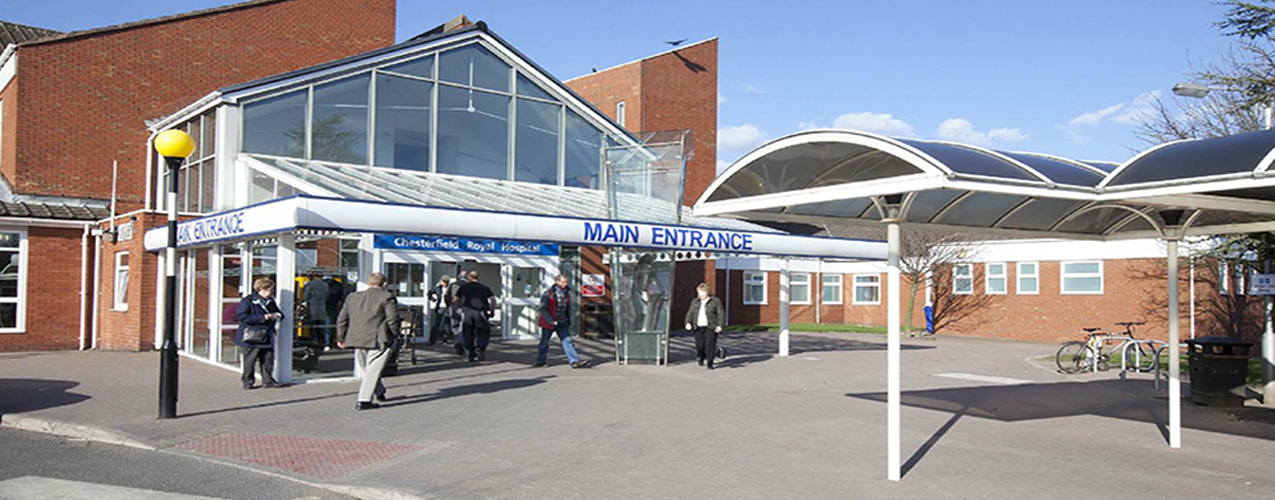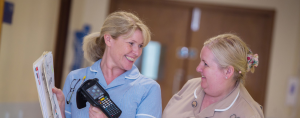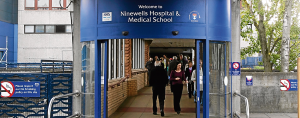Chesterfield Royal Hospital NHS Foundation Trust
Equipment tracking and cost reductions through tech
Challenge:
The devastating impact misplaced equipment can have on critical care – and hospital budgets
Based in the heart of Derbyshire’s Peak District, Chesterfield Royal Hospital, the only facility in its Trust, is a sprawling, low rise building – so designed to adhere to strict planning restrictions in an area of natural beauty. Each year its team of 4,500 staff and 150 volunteers, across 20 wards oversee 550 beds many of which are used to care for the 22,000 patients that receive complex surgery. The hospital delivers over 2,500 babies a year and treats 96,000 patients in its A&E department. Add to this the 8 million pathology tests that are carried out annually, Chesterfield Hospital’s position within the community is undeniably important.
As the hospital is so spread out, valuable time can be lost searching and walking thousands of steps to track down and retrieve medical devices that had been moved to another ward. These delays can be life-altering.
The Clinical Engineering (CE) team of 12 is in charge of audit and facilities management of Chesterfield’s huge library of medical equipment (which sits at 15,000 different devices and counting). The team was increasingly becoming anxious and frustrated with not only having to manually track critical devices, but also having to account for and replace misplaced equipment – especially in the face of an increasingly tight budget.
A manual data cleanse in 2019 saw the team write off 2,165 lost devices from its database. A lot of this equipment included items that could be perceived as low cost to many busy staff or even patients, such as infrared thermometers or a T34 Syringe Driver. Devices such as these cost between £50 and £1000 respectively, which result in a large financial tally when hundreds go missing over a 36-month period.
The CE team is also responsible for receiving and handling MHRA (Medicines and Healthcare products Regulatory Agency) alerts and manufacturer upgrades on devices like heart monitors. This means if the regulator finds a fault with a device it will notify the CE team, and it is then their responsibility to oversee repairs alongside the manufacturer.
Furthermore, to aid patients in leaving hospital when they are medically fit to do so but require medical equipment, the hospital regularly loans out some of its equipment to wider community bodies in need. This adds a complex dynamic to keeping an accurate inventory.
Stuart Barton, Specialist Clinical Engineer at Chesterfield Royal Hospital NHS Foundation Trust comments, “Much of the equipment we use day-in day-out can be considered life-critical. We needed to make sure that staff were able to work safely and deliver clinical excellence, but the challenge was mounting especially with COVID-19.
“There just simply wasn’t any room for error or lengthy searches for equipment when demand for services were so high. We also couldn’t afford the mounting costs of misplaced items; it was needless waste and there had to be a way to reduce it somehow.”
Much of the equipment we use day-in day-out can be considered life-critical. We needed to make sure that staff were able to work safely and deliver clinical excellence, but the challenge was mounting especially with COVID-19.
Stuart Barton
DSFS Specialist Clinical Engineer
Chesterfield Royal Hospital NHS Foundation Trust
Solution:
Implement a simple infrastructure, a device tracking
To counter this costly, laborious, manual process, the Trust rolled out iFIT, Idox’s medical asset and patient records tracking solution. The aim was to improve agility, deliver care faster and future proof itself for changing demands.
Idox installed a Radio Frequency Identification system (RFID). Simple to fit and implement, there are 142 readers and 271 antennas subtly integrated throughout the site’s 92,000 square metres. These communicate with smart labels which are placed on medical equipment as it passes through the hospital corridors.
This investment has allowed the hospital to better manage, monitor and locate its vast array of equipment. Initially purchased to aid the CE team track medical equipment, the success of the system has seen it rolled out site-wide with the IT, Estates and Education departments now entering equipment onto the system. This means there are currently 346 clinical and non-clinical users on the system, with over 7,000 assets currently tagged and requests coming in each day to add more. Among the items tagged are the Trust’s e-obs iPads which also provide access to the iFIT system from patients’ bedside if needed, allowing staff to track down what they need quickly and efficiently.
Lost or missing items can be tracked by hand-held units, and if a certain device cannot be located this can be updated onto the system to indicate its need for replacement. Notifications allow users to track down the item in question narrowing a search area and saving time and lives, in some cases.
The Trust also has hundreds of devices on loan or hired to the Trust. Monitoring these devices used to be a labour intensive paper-based exercise by a technician with a clipboard walking every inch of the hospital. Fitting temporary tags allows the team to actively track the equipment from the day it arrives until the day the equipment is returned, saving countless hours and reducing the Trust rental bill as well as increasing patient safety. The system also allows the team to conduct routine audits of areas across the hospital including the Equipment Library (inventory), and has increased productivity overall across the team.
With a complex network of hires and loans to consider, the iFIT tool has considerably alleviated much of the pressure on teams tasked with complete oversight and continued servicing of these devices.
As well as immediately reducing cost and ensuring quick delivery of vital equipment in an emergency, the panoramic view iFIT provides enables the CE team to improve patient flow. This is a result of utilising the right equipment allowing for beds to be freed up for the next patient.
Outcome:
Critical COVID-19 monitoring, enabling critical efficiency
The system was put to the test soon after instalment, as Chesterfield Trust faced a surge of in-patients in need of critical care. A Critical Care Unit, which normally relied heavily on expensive equipment like ventilators, dialysis units and monitoring equipment before the pandemic, was now having to expand and was also having to rely on PPE such as respirators as essential equipment. This meant the hospital had to be re-configured to ensure the Trust could cope with the increase in critical care patients being admitted, the correct care could reach those with COVID-19 while also allowing other elements of critical care and hospital business to continue ‘as usual’.
Another area of concern was the amount of oxygen being consumed by individual wards. The system allowed staff to easily monitor the location of oxygen-driven equipment to ensure the oxygen system was not overloaded by having the wrong type of CPAP or non-invasive ventilators in the wrong areas of the Trust. Actively monitoring the critical equipment in this way helped avoid a serious incident, protecting patients whilst maintaining the highest form of patient care by ensuring the greatest number of CPAP ventilators were stored in the same, correct place, maximising the efficiency and speed at which they could be transported to the relevant safe areas ensuring no time was wasted unnecessarily.
Stuart concludes, “Idox’s collaboration with the Trust so far has meant better support for colleagues in critical care and the wider hospital, improved patient safety and care, as well as efficiencies from reduction in clinician’s time spent looking for equipment. In a hospital, a matter of minutes can define a life-or-death situation, so every second saved using technology is invested in social good.”






